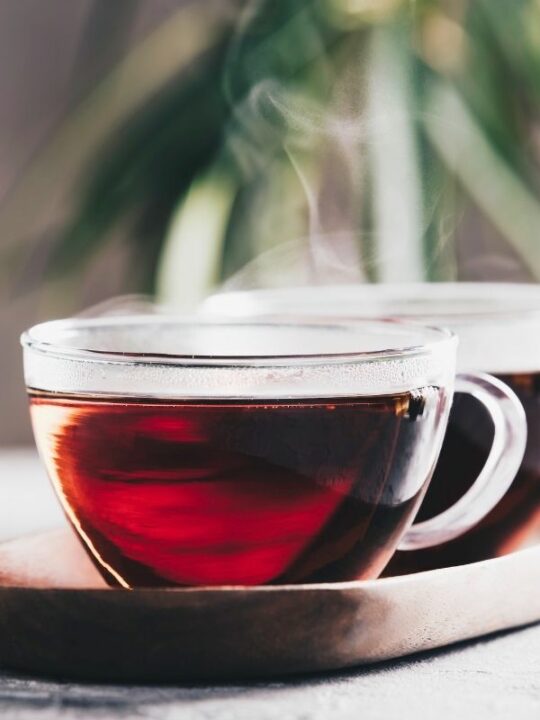There are as many reasons for drinking tea as there are tea drinkers. Some people like the boost caffeine gives them, while others are looking for a calming beverage at the end of the day.
No matter why you’re turning to tea, it’s important to know how to brew your beverage properly. Bitter tea and tepid water are neither refreshing nor enjoyable.
While the tactics you use will vary by tea variety, in this post we’ll break down the most important elements of that perfect cup of tea.
How do you make tea taste better?
A lot of variables go into a good cup of tea. Using good-quality tea leaves, the right temperature water and steeping for the right amount of time are important. If you’re adding a sweetener, milk or milk alternative, make sure you use the right proportions. Finally, remember to enjoy yourself!
1. Use good-quality tea leaves
The first way to go wrong with tea is to use low-quality tea.
You don’t have to buy the most expensive tea brand, and in fact some companies may engage in dishonest advertising to increase the prices they charge for an inferior product.
Doing a little bit of research about trusted brands and making sure the package you purchase is relatively fresh are both important. While tea doesn’t necessarily expire, old leaves won’t carry as much flavor.
In addition to buying good tea, it’s essential to follow good storage practices. Even the highest quality pu erh will taste bad if you don’t know how to store pu erh tea, for instance.
Figure out the best way to keep your tea leaves fresh, and you’ll be on the right track.
2. Use the right amount of leaves per cup
The next step is to add a correct amount of tea leaves.
If you’re using a teabag, you should normally use one bag per cup. For loose leaf, it’s important to know how much loose leaf tea for a cup.
Generally speaking, you want about one tablespoon per six ounce cup of tea. Check the package of your loose leaf tea to be on the safe side and adjust if the taste is off.
3. Use the right water temperature
It’s a common misunderstanding that all tea needs boiling water.
While that’s true for black tea, some other varieties need water that’s hot but not boiling. Check out our article on
the right water temperature for tea to get this step taken care of.
4. Don’t steep too long or too little
The steeping time for tea varies by tea type.
Don’t just ask, “how long should oolong tea steep for?” and assume you’re done. Black tea, white tea, green tea and any other tea variety has its own unique steeping time.
Some general guidelines are that black, oolong and pu erh tea should steep for 3-5 minutes, green and white teas should steep for around 1-2 minutes. Herbal teas can steep for 5 or more minutes in many cases, but it depends on the herbs you are using. Steeping tea for too long is one of the biggest reasons for bitter tea.
Of course, some people like stronger tea than others. If you find the tea tastes too weak or, on the other hand, too strong, adjust the time accordingly.
Many tea companies include recommended brew times on the package. For best results, experiment and see what works best for the specific tea you’re using and your own tastes.
5. Get the proportions right
We’ve already covered the right amount of tea leaves to add. However, many people enjoy their tea with a sweetener, milk or milk alternative.
Even if you know the best sweeteners for tea, it’s easy to add too much and turn your tea into a syrupy mess. Likewise, a cup of tea with too much milk or almond milk is basically just a cup of hot milk.
The standard recommendation is to add one fourth as much milk or milk alternative as you do water.
For sweetener, the recommended amount varies hugely depending on what you’re using. A couple of teaspoons of white sugar is probably plenty, but you might need more or less of other sweeteners like honey, maple syrup, agave nectar or coconut sugar.
Again, tastes differ, and you might enjoy a sweeter or milkier drink. As always, it’s best to start with the recommended amount and change it up if that’s not working.
6. Adjust as needed
Making good tea has a lot of steps, and while each one individually isn’t much work, doing all of them at once can seem overwhelming.
If you get it wrong a couple of times, don’t stress. Adjust your proportions or water temperature and try again. You’ll get there!
In the meantime, you can always learn how to reuse loose leaf tea leaves.
7. Don’t get hung up on the quest for perfection
Finally, it’s important to remember that drinking tea is supposed to be something you enjoy.
If you find that you’re spending more time trying to make tea than relaxing with a warm cup, make sure you take some time to reconnect with what brought you to tea in the first place, whether it’s the taste of white tea or a love for the most popular bubble tea flavors.
